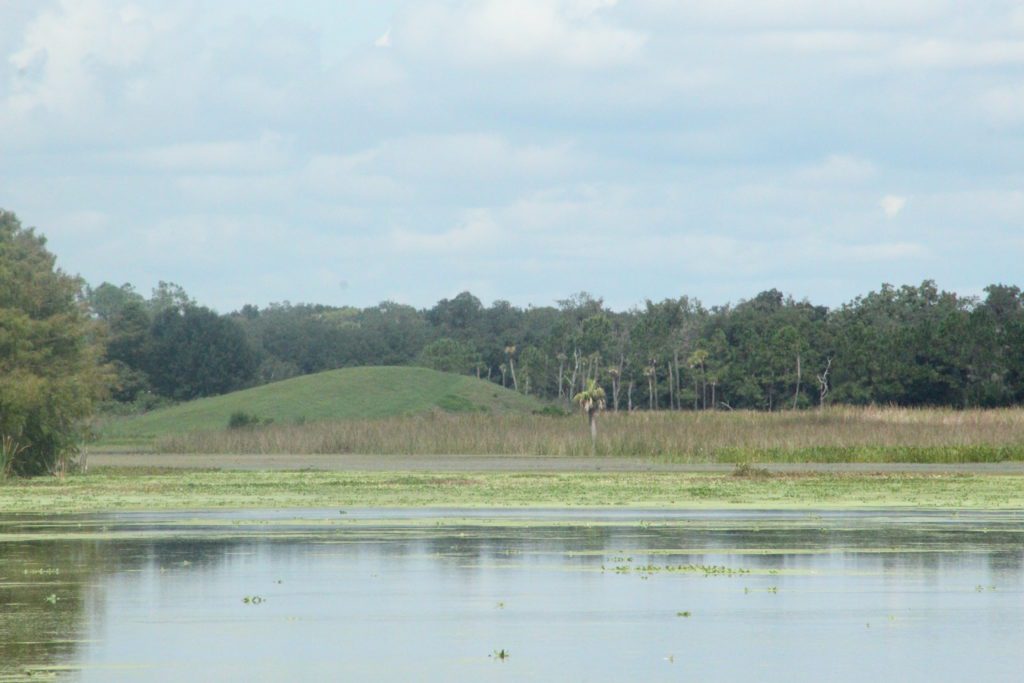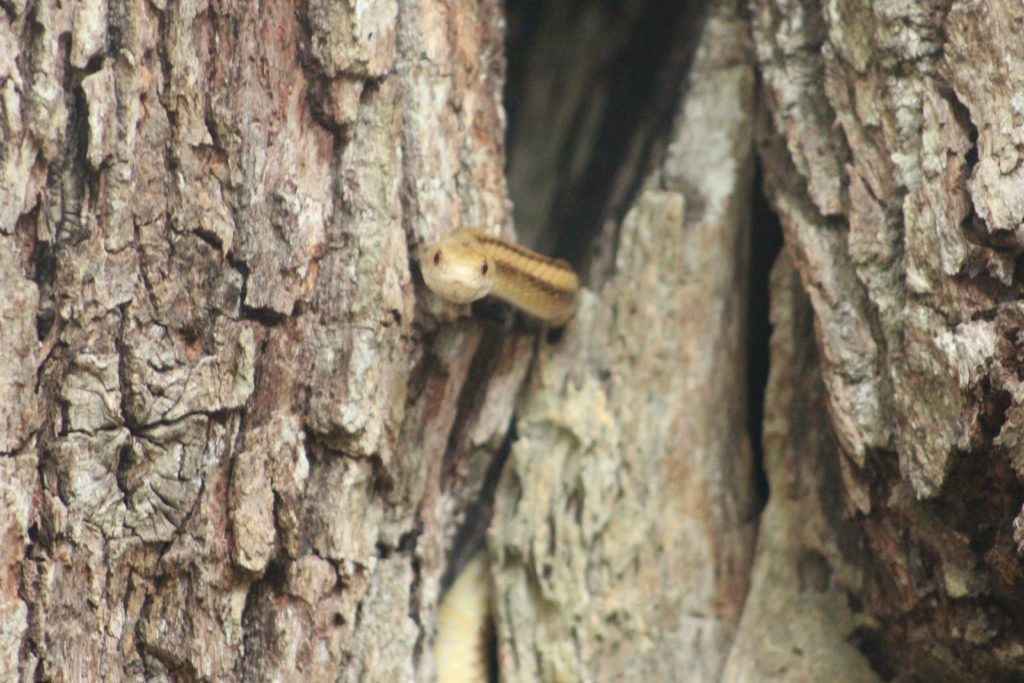The ecology of Orlando is vast and intertwined in a very fragile manner. Just outside of Orlando, Florida lies 1,650 acres of land dedicated to hiking, biking, wildlife viewing, and most importantly advanced water treatment. The regular visitor may be surprised to know the Orlando Wetlands is one aspect of City of Orlando’s elaborate water treatment facility. The man-made ecosystem utilizes naturally occurring processes to reduce the amount of nitrogen and phosphorus in the water.
The plants and animals that call the Orlando wetlands home not only contribute to the diverse ecosystem, the state park also absorbs more, carbon than it releases.9 This process allows the Orlando Wetlands to also be known as a “Carbon Sink”. The Orlando Wetlands are home to a plethora of plants and animals that aid in the treatment of water before the water’s inevitable discharge into the St. Johns River.4 As a hiking trail, the Orlando Wetlands is nothing short of a breathtaking experience every visit.
The Ecology Of Orlando And Water Treatment
The Orlando Wetlands is part of a greater water purification process the city undergoes to prevent excessive harm to the environment. The 35 million gallons of water sent to the wetlands a day predominantly originates from a facility known as the “Iron Bridge”2. The Iron Bridge is designed to benefit 400,000 citizens across Orlando and surrounding counties.

Photo by: Ronald Jones III
Ecology Of Orlando Continued
One of the most interesting parts of the Orlando Wetlands is the environmental ecology that goes into the design of the state park. Water entering the Orlando Wetlands Begins in a deep marsh area containing monocultures of Giant Bulrush and Cattails3. The Cattails and Giant Bulrush aid in extracting a majority of the nitrogen and phosphorus from the water before it flows through the rest of the park. Cattails and Giant Bulrush utilize phytofiltration which is a process some plants undergo, which allows them to take many harmful toxins from the ambient soil and water22. Through their unique properties plants like cattails can absorb a wide range of toxic metals including arsenic, nickel, and plutonium22.

Cattail Photo by: Ronald Jones III
Bulrush photo by: Road, P. Retrieved from The Nature Collective
Once the water leaves the deep marsh area, it then enters the mixed marsh area which is home to “60 submerged and emergent herbaceous species,”3 These species work together to further extract nutrients from the water allowing it to inevitably be released in the St. John’s River.
The Mixed Marsh isn’t just home to many plants but the wildlife that the Orlando Wetlands homes make the park a must-see for birders and wildlife enthusiasts.

Photo by: Ronald Jones III
The Ecology Of Orlando And Carbon Sink
As a result, the ecology of Orlando needed for a creative way to treat water, the wetlands 1987 original designers were also able to effectively create the foundation for a carbon sink. The term carbon sink refers to any environment or ecosystem that absorbs more carbon dioxide than it releases⁹. Plants including the Bald Cypress are used in the Orlando Wetlands design because they have the ability not only to take the harmful toxins out of the water but store an exceptional amount of carbon.17
Wetlands can store significant amounts of carbon according to the “1999 UN Wetlands Climate change frameworks”18. Amongst other things the creation, restoration, and maintenance of wetland environments allows the natural functions of these environments to occur, functions that are important to human survival like flood mitigation and most importantly carbon storage.

Photo by: Ronald Jones III
Wildlife & Endangered Species Conservation
The ecology of Orlando makes for a birders paradise, the Orlando Wetlands houses a plethora of rare and uncommon birds listed as threatened or endangered by the state of Florida including Roseate Spoonbills, Little Blue Herons, and even Tri-colored Herons¹⁰. The Orlando Wetlands has even been able to become a vital part of the migratory patterns of many birds like the Roseate Spoonbill.13
The Orlando Wetlands is an amazing expanse of hiking trails and water that looks like a scene taken directly out of Jurassic Park, even featuring Florida’s dinosaur, the American Alligator. The alligators call the wetlands their home and can be seen watching you visit from as close as ten feet away!
The Orlando Wetlands pose safety concerns since they house some dangerous animals like alligators. Here are some tips for anyone looking to visit the Orlando Wetlands:
-
Respect the wildlife
- Alligator attacks are particularly rare and should not be seen as a major safety concern to tourists when visiting the Orlando Wetlands. Primarily eating small fish, mammals, and amphibians, these prehistoric beasts rarely attack people¹². Tourists should remember that being chased by an alligator is highly unlikely, the best precaution is to keep your distance. Alligators are oftentimes considered to be slow-moving creatures but don’t let their reputation fool you, on land alligators can reach speeds up to 35 miles per hour. Those eco-tourists that are still frightened of the glaring eyes of the American Alligator should remember that running in a zig-zag formation will not deter alligators.⁸
-
Leave pets at home
- Pets, like dogs and cats, are strictly prohibited from the Orlando Wetlands3 for good reason because alligators do not understand the differences between domesticated animals and a food source, even the slightest splash at the edge of the water could mean bad news for the family pet.
-
Dress comfortably
- Although it may be tempting to enjoy a nice picnic on top of Oylers Overlook, the thirty-foot earthen mound allows visitors to see an amazing view of the wetlands, remember that hiking requires clothing that will allow you to move comfortably and protect from the elements.

Photo by: Ronald Jones III
Orlando Wetlands Wildlife Facts
If you are a novice to hiking and the environment, here are some fun and interesting facts you can share with your friends and family on hikes that will make you look like an expert!
-
Anhinga
- One of the most easily recognizable wetlands animals, the Anhinga is a black water bird that is known for its long slender neck²⁰. If you visit the Orlando Wetlands there is a 100% chance you will find this peculiar creature perched tall with its wings outstretched to dry. Anhingas, unlike most other aquatic birds, do not have waterproof feathers; this allows anhingas to be excellent swimmers, often being seen with only their snake-like necks out of the water resembling an aquatic snake²⁰.

Photo by: Ronald Jones III
-
Common Gallinule
- The Common Gallinule is a black wetlands bird that is oftentimes no larger than a pigeon. Often characterized by the red face and beak, these birds are seemingly nature’s cross between ducks and chickens. Often found wading in slow-moving waters picking at vegetation and small snails. These birds will often build “dummy nests” to fool predators during nesting seasons.23

Photo by: Ronald Jones III
-
Florida Brown Snake
- A non-venomous snake species indigenous to Florida, this beautiful snake, although non-venomous, can secrete a foul-smelling musk from glands found within the snake’s tail¹¹. Often found in leaf litter and old logs, watch your step around these guys because they have been known to make bluffing strikes at those who may endanger it.

Photo by: Ronald Jones III
-
Marsh Rabbit
- Marsh rabbits are distinguishable due to their small short ears and their reddish-brown coat¹, looking extremely different from their Eastern Cottontail counterparts. Particularly agile swimmers marsh rabbits although not particularly suited for aquatic life²¹, Marsh rabbits have particularly short fur on their hindlegs and long hind toenails¹. Also, they enjoy making thick clumps of cattails and other dense thickets into their homes. They are the only form of cottontails in the eastern United States that do not have a white cottontail21.

-
Spatterdock Lily
- This emergent water plant is a common plant for water gardens and creates homes for water invertebrates like snails that other animals in the ecosystem feed on¹⁵. Furthermore, deer and other grazing animals can eat their stems and seeds. Indigenous Americans boiled the roots of this plant for medicinal tea, and the seeds of the plant can be eaten either raw or roasted⁶.

Photo by: Ronald Jones III
Orlando residents can even volunteer at the Orlando Wetlands performing tasks ranging from photography to plant removal, To volunteer simply visit the Orlando Wetlands website and fill out the online volunteer application. To schedule your visit to the Orlando Wetlands please visit their website for more information about visiting times and other visitation options like guided tours.
Works Cited
- Animalia. (n.d.). Marsh Rabbit. Retrieved from Animalia: https://animalia.bio/marsh-rabbit
- City of Orlando. (2020). Orlando Easterly Wetlands Reclamation Project: From Experiment to success. Retrieved from City of Orlando.
- City of Orlando. (2020). Orlando Wetlands Park Map & Guide. Retrieved from City of Orlando: https://www.orlando.gov/files/sharedassets/public/departments/parks-amp-rec/orlando-wetlands-park/wetlands-guide_updated-2-17.pdf
- City Of Orlando. (2021, September). Orlando Wetlands Park. Retrieved from City of Orlando: https://www.orlando.gov/Parks-the-Environment/Directory/Wetlands-Park
- City of Orlando. (n.d.). Flora and Fauna Checklist. Retrieved from City of Orlando Water Reclamation: https://www.orlando.gov/files/sharedassets/public/departments/parks-amp-rec/orlando-wetlands-park/compressed_flora-fauna_for-print-on-copier.pdf
- College of Agriculture Food and Environment. (n.d.). Common Spatterdock. Retrieved from College of Agriculture Food and Environment: https://oepos.ca.uky.edu/content/common-spatterdock
- Earth Talk. (2020, January 27). Which Trees Best Offset Global Warming? Retrieved from Thought Co.: https://www.thoughtco.com/which-trees-offset-global-warming-1204209
- Experiance Kisssimmee. (2020, March 20). 7 Surprising Alligator Facts You Maybe Didn’t Know. Retrieved from Experience Kissimmee Florida: https://www.experiencekissimmee.com/blog/7-alligator-facts-you-probably-didnt-know
Works Cited Continued for Ecology Of Orlando
- Fern. (2016, November 1). What are Carbon Sinks? Retrieved from Fern: https://www.fern.org/publications-insight/what-are-carbon-sinks-332/?gclid=CjwKCAjwvuGJBhB1EiwACU1AiUh6pN6LCvDT0GKToeDTn4zxOD95DWXhsHpp9ZrNpy3TzSD4d6WrzRoCHAgQAvD_BwE
- Florida Administrative Code & Florida Administrative Register. (2021, May 27). Retrieved from Florida Department of State: https://www.flrules.org/gateway/RuleNo.asp?title=RULES%20RELATING%20TO%20ENDANGERED%20OR%20THREATENED%20SPECIES&ID=68A-27.003
- Florida Museum. (n.d.). Florida Brown snake. Retrieved from Florida Museum: https://www.floridamuseum.ufl.edu/florida-snake-id/snake/florida-brownsnake/
- Herpetology Program. (n.d.). How to be safe around Alligators. Retrieved from Savannah River Ecology Laboratory University of Georgia: https://srelherp.uga.edu/alligators/alligator-safety.htm
- Kaufman, K. (2021, August 31). Ask Kenn: Why Have Roseate Spoonbills Invaded the North This Summer? Retrieved from National Audubon Society: https://www.audubon.org/news/ask-kenn-why-have-roseate-spoonbills-invaded-north-summer
- Mazzotti, D. R. (2017). Threats to Florida’s Biodiversity1. University of Florida IFAS Extension.
- Missouri Department of Conservation. (n.d.). Spatterdock (Yellow Pond Lily). Retrieved from Missouri Department of Conservation: https://mdc.mo.gov/discover-nature/field-guide/spatterdock-yellow-pond-lily
- Nahlik, A., & Fennessy, M. (2016, December 13). Carbon storage in US wetlands. Retrieved from Nature Communications: https://doi.org/10.1038/ncomms13835
- National Geographic Society. (2020, March 26). Carbon Sources and Sinks. Retrieved from National Geographic: https://www.nationalgeographic.org/encyclopedia/carbon-sources-and-sinks/
- Orlando, B., & Bergkamp, G. (1999, October). Wetlands and Climate Change: Exploring collaboration between the Convention on Wetlands (Ramsar, Iran 1971) and the UN Framework Convention on Climate Change. Retrieved from The City of Orlando: https://portals.iucn.org/library/sites/library/files/documents/Rep-PDF-1999-001.pdf
- Road, P. (2013, August). California Bulrush. Retrieved from The Nature Collective: https://thenaturecollective.org/plant-guide/details/california-bulrush/
- The Cornell Lab. (n.d.). Anhinga Identification. Retrieved from All About Birds: https://www.allaboutbirds.org/guide/Anhinga/id#
- Whitaker, J. O. (1998). Marsh Rabbits. In J. O. Whitaker, Mammals of the eastern United States (pp. 178-179). Ithaca, N.Y.: Comstock Publishing Associates.
- Yan, A., Wang, Y., Tan, S. N., Mohd Yusof, M. L., Ghosh, S., & Chen, Z. (2020). Phytoremediation: A Promising Approach for Revegetation of Heavy Metal-Polluted Land. Frontiers in Plant Science.
- Tennessee Wildlife Resources Agency. (n.d.). Common Gallinule. Retrieved from Tennessee Wildlife Resources Agency: https://www.tn.gov/twra/wildlife/birds/waterbirds/common-gallinule.html








